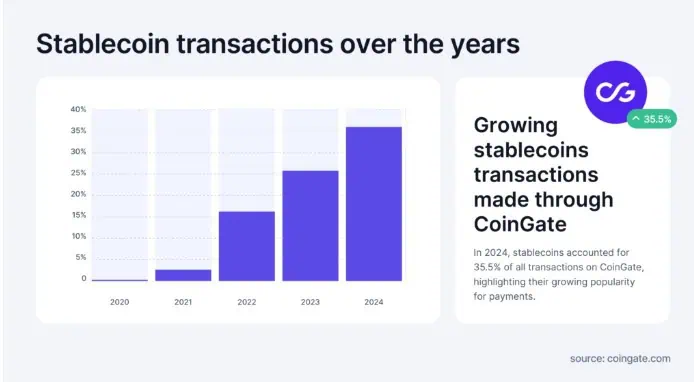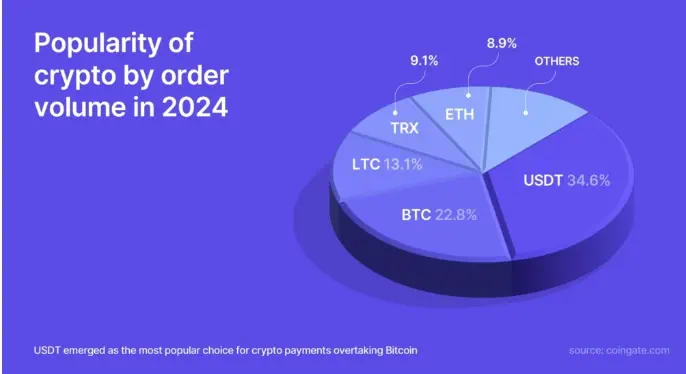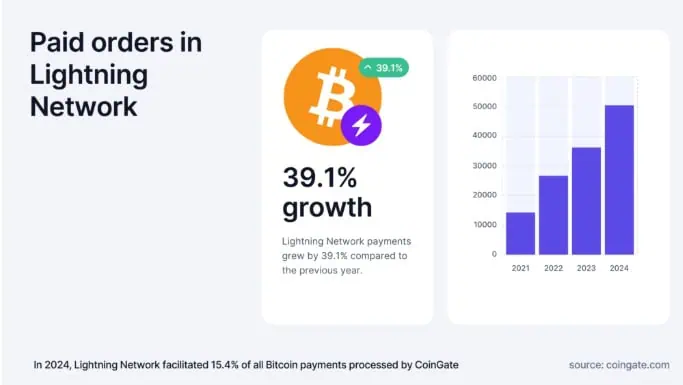
Stablecoins, led by USDT, have established themselves as the preferred payment method in 2024, accounting for 35,5% of commercial payment transactions involving crypto assets.
2024 marked a milestone in the adoption of cryptocurrencies as a payment method, and stablecoins were the undisputed protagonists. According to the annual cryptocurrency payments report published by CoinGate, stablecoins accounted for 35,5% of all transactions processed, consolidating themselves as the preferred option for both users and merchants. This growth reflects a clear trend towards stability and efficiency in the digital payments ecosystem.
The dominance of stablecoins in commercial payments
Stablecoins, cryptocurrencies pegged to stable assets such as the US dollar, have gained traction in recent years due to their ability to offer stability in a market known for its volatility.
In 2024, USDT, the stablecoin issued by Tether that leads the market in terms of capitalization, also led this segment of crypto payments, accounting for 97,2% of all stablecoin business transactions. It was followed by USD Coin (USDC), with 2,5% and DAI, with just 0,3%, according to the report. report.

The report also highlighted that the use of stablecoins has grown exponentially since 2022, when they accounted for only 16% of payments. In 2023, this figure increased to 25,4%, and in 2024 it reached 35,5%. This growth is not only due to their stability, but also to their integration into more efficient blockchain networks and regulatory clarity in key regions such as Europe and the United States.
USDC, the fastest growing stablecoin
While USDT maintained its dominance, USDC was the fastest-growing stablecoin in 2024, recording an 86,9% increase in usage. This boost is primarily attributed to its integration into the Solana network in May 2024, which enabled faster and cheaper transactions. Solana became the second most popular blockchain network for USDC payments, experiencing a notable increase in order volume between October and November.
On the other hand, while stablecoins gained prominence, Bitcoin (BTC) and Ethereum (ETH) experienced a decline in their share as payment methods. In 2023, Bitcoin accounted for 35,6% of transactions, but in 2024 this figure fell to 22,8%. Ethereum, on the other hand, continued to lose influence, going from 11,2% in 2023 to 9,5% in 2024.
The above data reflects a growing preference among users for more stable assets and more efficient blockchain networks. TRON, for example, surpassed Bitcoin as the most used network for payments., accounting for 31,5% of transactions in 2024. The majority of these transactions on TRON were made with USDT, underscoring the central role of stablecoins in this ecosystem.

The rise of Layer 2 solutions
Layer 2 solutions such as Bitcoin’s Lightning Network, Polygon, and Ethereum’s Arbitrum also played a key role in the evolution of cryptocurrency payments in 2024. According to the report, the Lightning Network, designed to improve the scalability of the Bitcoin network, saw a 39,1% increase in usage, processing 15,4% of all BTC transactions.
Polygon, meanwhile, saw a 135% growth in transactions, driven primarily by the rise in the use of USDT and its native token, POL. Arbitrum, a Layer 2 solution for Ethereum, saw a spectacular 565% increase in adoption, thanks to the growing interest in ETH and USDT payments.

Regional trends and merchant preferences
On the other hand, CoinGate's report also revealed interesting regional trends regarding the use of cryptocurrencies and digital assets as means of payment. For example, it noted that The United States remained the most active country in cryptocurrency payments, accounting for 21% of all paid orders. Germany and the UK came in second and third place, with shares of 6,5% and 5,7% respectively.
However, emerging markets also showed notable growth. Nigeria, for example, saw its share rise by 0,42%, reaching 5,08% of total transactions. Ukraine also stood out, with growth of 0,61%, reflecting the accelerated adoption of cryptocurrencies in regions with economic and financial challenges.
Merchants also showed a clear preference for stablecoins when settling their payments. 71,43% of merchants chose to settle their payments in euros, suggesting that there is still some reluctance to hold funds in cryptocurrencies. However, 16,7% of settlements were made in stablecoins, an increase of 4,2% compared to data recorded in 2023. Overall, this growth, although modest, reflects increased confidence in stablecoins as stable and regulatory-compliant assets.
7,92% of traders chose to liquidate in Bitcoin, indicating that some view BTC as a valuable asset in the long term.
Cryptocurrency and stablecoin payments in 2025
CoinGate's report paints an optimistic picture for the future of cryptocurrency payments. Stablecoins, especially USDC, are expected to further cement their position as a preferred payment method, thanks to their compliance with regulations such as Mica in Europe.
Furthermore, the adoption of Layer 2 solutions and emerging networks such as Solana and TRON will continue to improve the efficiency and scalability of cryptocurrency payments. These innovations will not only benefit users but also open up new opportunities for merchants looking to integrate cryptocurrencies into their operations.
Taking all of the above into account, the report concluded that 2024 has cemented itself as the year of stablecoins, which are now seen as the backbone of cryptocurrency payments, offering stability, efficiency, and regulatory compliance. With a 26,2% growth in their transaction volume, stablecoins are poised to lead the next wave of digital payments adoption.


